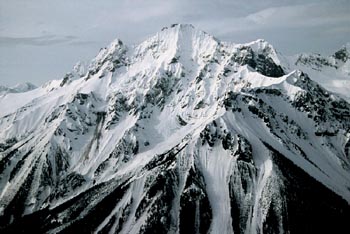Plinth Peak facts for kids
Quick facts for kids Plinth Peak |
|
|---|---|

North face of Plinth Peak
|
|
| Highest point | |
| Elevation | 2,677 m (8,783 ft) |
| Prominence | 947 m (3,107 ft) |
| Geography | |
| Location | British Columbia, Canada |
| Parent range | Pacific Ranges |
| Topo map | NTS 92J/12 |
| Geology | |
| Age of rock | Pleistocene |
| Mountain type | Stratovolcano |
| Volcanic arc/belt | Canadian Cascade Arc Garibaldi Volcanic Belt |
| Last eruption | Pleistocene |
| Climbing | |
| First ascent | 1931 N. Carter; A. Dalgleish; T. Fyles; M. Winram |
| Easiest route | rock/ice climb |
Plinth Peak, also known as Plinth Mountain, is a tall mountain in British Columbia, Canada. It is actually a type of volcano called a stratovolcano. Plinth Peak is the highest part of a larger group of volcanoes known as the Mount Meager massif. It is one of four volcanoes that make up this big volcanic area. This area is part of the Garibaldi Volcanic Belt, which is a chain of volcanoes in western Canada. Plinth Peak is one of the most recently formed volcanoes in the Mount Meager massif.
Contents
About Plinth Peak
Plinth Peak stands tall as the highest volcanic peak within the Mount Meager massif. It reaches an elevation of 2,677 meters (about 8,783 feet) above sea level. This makes it a significant landmark in the Pacific Ranges of British Columbia.
What is a Satellite Cone?
Plinth Peak is described as a "satellite cone." Imagine a main, large volcano. A satellite cone is like a smaller, separate volcano that grows on the side or near the main one. Plinth Peak is one of these smaller volcanoes connected to the larger Mount Meager massif.
A Look Inside Plinth Peak
On the steep northern side of Plinth Peak, you can find what's left of an old crater wall. A crater is the bowl-shaped opening at the top of a volcano. This part of the wall was destroyed a very long time ago, about 2,350 years ago.
The Ancient Blast
The destruction of the crater wall happened during a period of volcanic activity. A powerful event called a "lateral blast" occurred. This is when an eruption explodes sideways from the volcano, rather than straight up. This huge blast changed the shape of Plinth Peak's crater.
When Plinth Peak Formed
Plinth Peak formed during the Pleistocene epoch. This was a geological time period that began about 2.6 million years ago and ended about 11,700 years ago. This means Plinth Peak is quite old, but it's still considered one of the newer parts of the Mount Meager massif.
First Climbers to the Top
The first recorded climb to the summit of Plinth Peak happened in 1931. A group of climbers, including N. Carter, A. Dalgleish, T. Fyles, and M. Winram, successfully reached the top. The easiest way to climb Plinth Peak involves rock and ice climbing, showing it's a challenging ascent!

